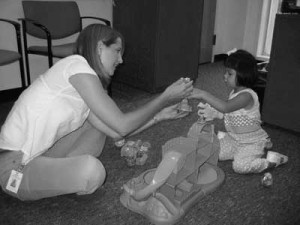
In the years of doing ABA, I have realized how important play skills are for children and especially children with autism. It is during play that children learn:
* appropriate behavior
* task completion
* imagination
* turn taking
* building relationships
* joint attention
* imitation
* appropriate language
* tolerance to a variety of ways to play with toys
* reciprocal interaction
and most of all to have fun. Play, essentially, is an important skill that compliments ABA and generalizes skills taught formally.
Below are brief summaries of clients that I have worked with who, after years of dedication, learned to have fun with toys.
One child I worked with started with no play skills and did not enjoy formal teaching of play. After three years of rigorously playing with a variety of toys, he now has favorite toys and will spend time independently playing.
Although there are kids who must be taught formally on how to play by putting play tasks in an ABA program, this particular child was not having fun. The team worked especially hard to motivate this child to play. This particular play program was taught informally and had to be fun. Attention to a task was also difficult for this child, as he would not sit for more than a few seconds at a time.
During countless sessions, I did everything possible to make this child ENJOY play and not just go through a rote script that was taught to him. I used a lot of social reinforcement, as this was something he liked. As an example, the child and I would build blocks and then crash them. When the blocks crashed, I fell back and pretended that I was dead. This sparked laughter, so we did it again and again. Another instance that I can recall is playing a bead maze. As a way to prolong sitting and playing, I would make funny noises or change the tone of my voice when talking. This child enjoyed this tremendously. I was able, through social interaction, to pair this enjoyment with playing.
Sitting down to play with a toy has also gradually increased and he now sits for up to 15 minutes playing with a variety of toys.
This child is now 5 years old. Through years of dedication, our team was able to drop our SD voice and formal teaching style and have fun with play. In turn, this child learned that playing IS fun and it is not a chore that must be completed.
Now, when I do therapy, this little boy will sit happily playing with one of his favorite toys while I set up a program. Every time I see this, I smile and always treasure these precious moments.
Since each child with autism is unique and possess different strengths and weaknesses, I have had other clients in which there was a formal toy play program. Play was geared towards appropriate usage of certain toys. For example, when teaching play-dough, certain tasks were targeted such as rolling play-dough with a rolling pin, cutting play-dough and making shapes from cookie-cutters. For these children, SD voices were used, but in a natural tone of voice.
After targeting task in play, this child will now naturally roll play-dough with a rolling pin and enjoys making countless shapes from cookie-cutters. As well, therapists have also taught numerous other play tasks for play-dough in a natural manner such as making snakes, balls, or spaghetti from the play-dough machine.
For other children, certain rigidity patterns were targeted in a toy play program. For instance, a child may string beads in a certain order, or must complete the whole task of beading and cleaning up with no interruptions. For children that have rigidity behaviors, therapists work at breaking these patterns by interrupting a child’s play sequence, or changing it up. As an example, to disrupt a ritualistic behavior I often play “dumb” and do other things with the toy. For example, if a child always has to put the basket ball through the hoop, I put a block through the hoop or bounce the basket ball around. In the beginning, children with autism will resist any change in their play, and therefore will try anything to make a therapist stop. It is the therapist’s job, however, that once a goal has been set, to go through with whatever you are doing. It is important, however, to follow the program supervisors suggestion on the amount of disrupting rigidity behavior as to not overwhelm the child. Children with autism will soon learn to tolerate other ways to play with a toy and may even find it entertaining and fun along the way.
Related posts:
- Characterizing Autism The varied behaviors of autism make the disorder extremely difficult...
- A General Overview of Autism and ABA Therapy The use of ABA therapy to teach child autism has...
- Understanding Autism and Autism Treatments It was my father who gave me my first gut-level...
Comments are closed.